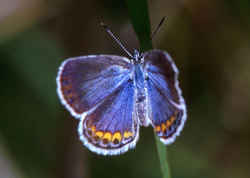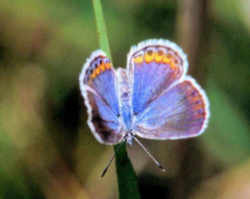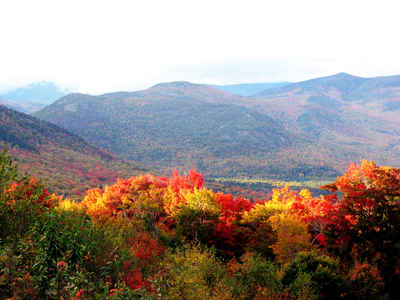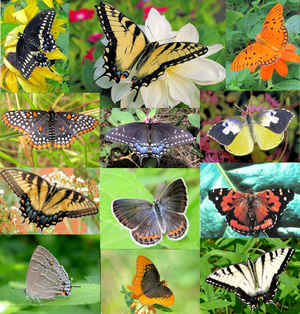New Hampshire State Butterfly
Karner Blue Butterfly

(Lycaeides melissa, subspecies samuelis)
Adopted on April 3, 1992.
The Karner Blue, (Lycaeides melissa, subspecies samuelis,) was the designated as the official New Hampshire State Butterfly on April 3, 1992. The Karner Blue butterfly, also known as the Melissa Blue, is found in small isolated colonies in New Hampshire and elsewhere.
New Hampshire Revised Statutes Annotated (RSA) 3:18
Opler, Paul A. Butterflies East of the Great Plains: An Illustrated Natural History p.120.
New Hampshire State Butterfly: Karner Blue

The Melissa Blue (Lycaeides melissa) is a butterfly of the Lycaenidae family. It is found in Western North America, from Canada to Mexico.
The Karner Blue (Lycaeides melissa samuelis) is a subspecies of the Melissa Blue, and was described by the novelist/lepidopterist Vladimir Nabokov. It is sometimes placed in the genus Plebejus.
Karner blue butterflies are legally protected in New Hampshire. Possession and take (which includes harming, harassing, injuring and killing) is illegal.
NH Conservation Status: Endangered
Characteristics of the New Hampshire Karner Blue Butterfly
Melissa Blue (Lycaeides melissa [W. H. Edwards])
Wing span: 7/8 - 1 3/8 inches (2.2 - 3.5 cm).
Identification: Upperside of male blue with narrow dark border; female brown with blue tinge. Underside with continuous black line along outer margin of both wings. Red-orange submarginal row is continuous in subspecies melissa and divided into separate spots in subspecies samuelis.
Life history: Males patrol near host plants for females. Eggs are laid on assorted parts of the host plant or on nearby debris. Caterpillars eat young leaves and are tended by ants who feed on the caterpillars' sugary secretions.
Flight: Two broods from May-August for the Karner Blue (subspecies samuelis) in the East; three broods from April-October for subspecies melissa in the West.
Caterpillar hosts: Lupine (Lupine perennis) for the Karner Blue. The western population feeds on various legumes of the pea family including Astragalus, Glycyrrhiza, Lotus, Lupinus, and Medicago species.
Adult food: Adult Karner Blues have been observed nectaring on over 50 different species of flowers. They seem to select the nectar species with the greatest total number of flowers or flowering heads, usually yellow or white.
Habitat: Karner Blue (subspecies samuelis) inhabits sandy pine prairies, barrens, and lakeshore dunes in the east. Subspecies melissa is found in the west in open, weedy areas and prairies.
Range: The small, isolated colonies of the Eastern population (subspecies samuelis) occur from southern New Hampshire and central New York west to Wisconsin. The western population (subspecies melissa)) is found in the Intermountain West from Canada to Baja California, plains, and prairies east to northwestern Iowa and southwestern Minnesota.
New Hampshire Law
The law designating the Karner Blue as the official New Hampshire state butterfly is found in the New Hampshire Statutes, Title 1, Chapter 3, Section 3:18.
Title I: The State and Its Government.
Chapter 3: State Emblems, Flag, Etc.
Section 3:18
3:18 State Butterfly. - The Karner Blue, Lycaeides melissa, subspecies samuelis, is hereby designated as the official state butterfly of New Hampshire.
Source. 1992, 22:1, eff. June 2, 1992.
Taxonomic Hierarchy: Karner Blue
Kingdom: Animalia (Animals)
Phylum: Arthropoda (Arthropods)
Subphylum: Hexapoda (Hexapods)
Class: Insecta (Insects)
Order: Lepidoptera (Butterflies and Moths)
Superfamily: Papilionoidea (Butterflies and Skippers)
Family: Lycaenidae (Blues, Coppers, Hairstreaks, Harvesters)
Subfamily: Polyommatinae (Blues)
Genus: Plebejus
Species: melissa (Melissa Blue)
Subspecies; samuelis (Karner Blue)
Butterflies, and Bugs








